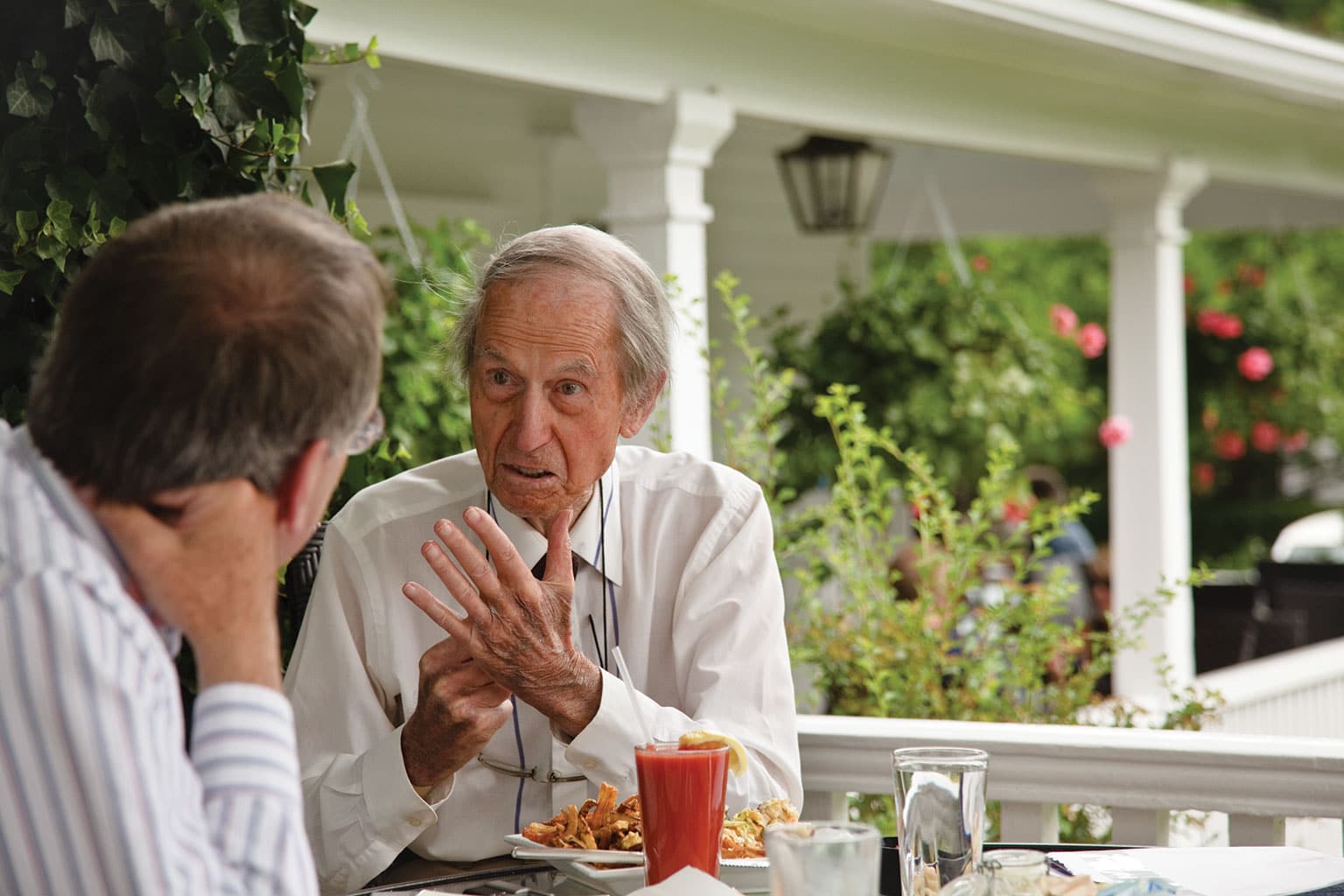Lunch with... John Fitch
He was shot down over Germany in WWII, received a kiss from Evita for winning the Argentine GP – in fact, over 93 years, there isn’t much this American hasn’t done
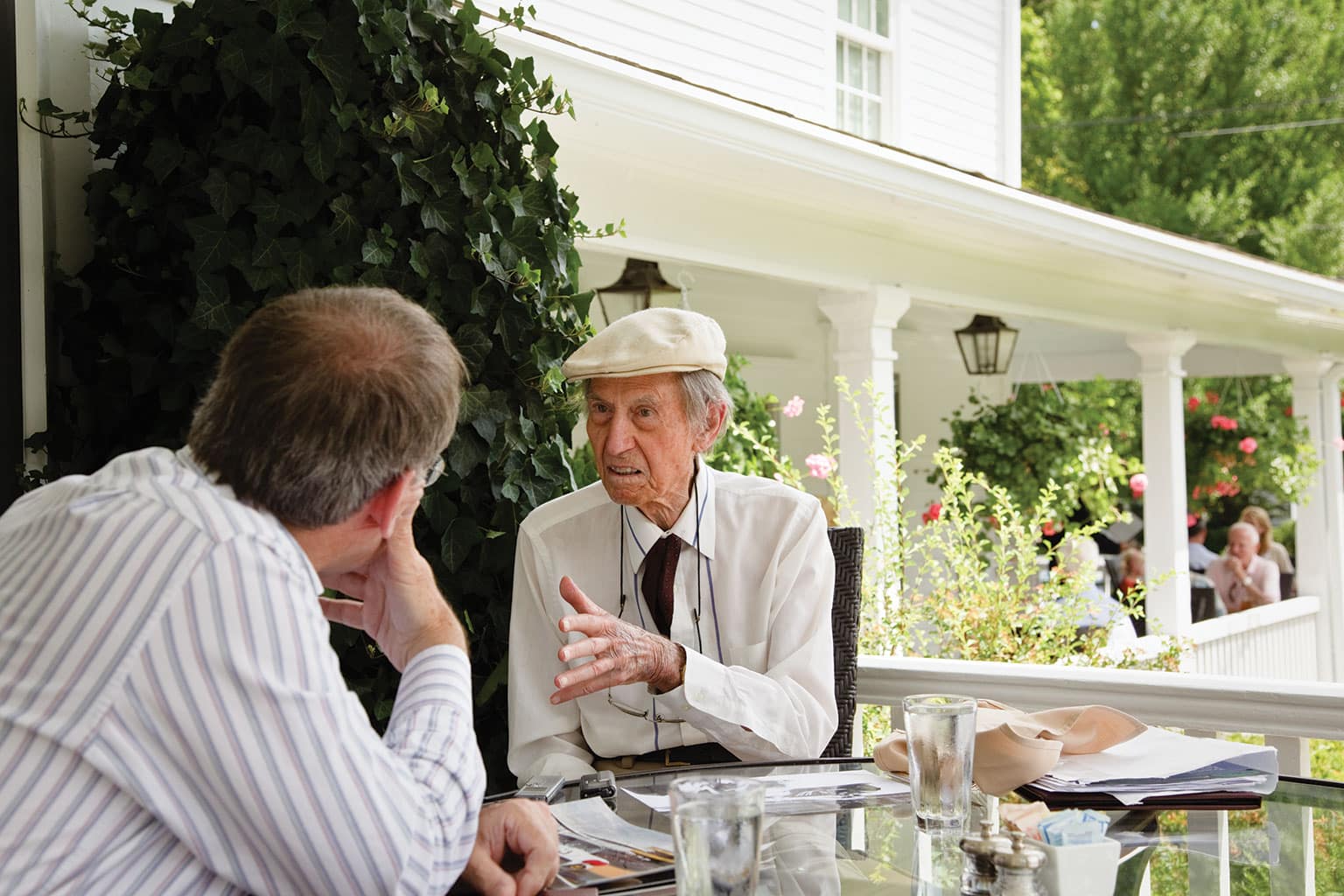
Jake Wyman
Even if John Fitch had never sat in a racing car, his extraordinary life would still be the stuff of legend. Fighter pilot, sailor, inventor, farmer, prisoner of war, car designer, safety campaigner, race track director: John has packed a lot into his 93 years. As it was, his 18 racing seasons included drives for Mercedes in the Carrera Panamericana, the Mille Miglia and the Targa Florio, as well as the fateful 1955 Le Mans 24 Hours. He was a works driver for HWM, Healey, Cunningham and Frazer Nash, and rallied for Sunbeam-Talbot, winning a Coupe des Alpes. He masterminded General Motors’ success at Sebring and Le Mans with the Corvette, and he won the Argentine Grand Prix in a borrowed Allard, earning a kiss from Evita. During the golden age of 1950s sports car racing he knew everybody on the European and American scenes: saluted their victories, shared in their parties, mourned their tragedies. And he remembers them all. With pin-sharp recall and extrovert good humour, he has the mental energy and inquiring mind of a man 50 years his junior.
John comes from an old-established American family: his 18th century namesake built the first successful steamboat in 1787. For more than half his life he has lived a stone’s throw from the Lime Rock circuit, in a fine old Connecticut house that was built before the Revolution. We take lunch in the gracious White Hart Inn, another old colonial building in nearby Salisbury. Tall and beanpole slender, John has a healthy appetite, tucking into soup, bratwurst, pecan pie and ice cream. Six hours later we’re still talking, now back at his house surrounded by piles of papers – “work in progress”, says John – and tottering towers of the books that he continues to read voraciously.
His introduction to cars came from his stepfather George Spindler, who was a senior director in the Stutz Motor Company. “A brilliant man, half German, half French, spoke many languages fluently. He raced on the beach at Daytona, and ran a car in the 1929 Indy 500 for Babe Stapp. An early memory is him taking me round the Indy bowl in a Black Hawk.
“I went to Kentucky Military Academy, and then studied engineering at Lehigh University. By 1938, when I was 21, it was clear to me that Hitler was coming and there was going to be a terrible war. I decided to see Europe before it was destroyed, so I crossed the Atlantic on a Dutch freighter and ended up in Amsterdam. My plan was to go to Paris, buy a horse and ride it to Rome, picking up French and Italian as I went. I thought that if I was hungry nobody would be interested in an American wanderer, but they might take pity on the horse. But with war clouds gathering I couldn’t get the visa I needed. So I went to London and lived on a Thames barge, and for some reason I ended up at Brooklands, watching Prince Bira and Freddie Dixon. The racing I’d seen in America, just going round and round, never moved me. But these cars used their brakes and gears, they turned corners both ways. I was fascinated.
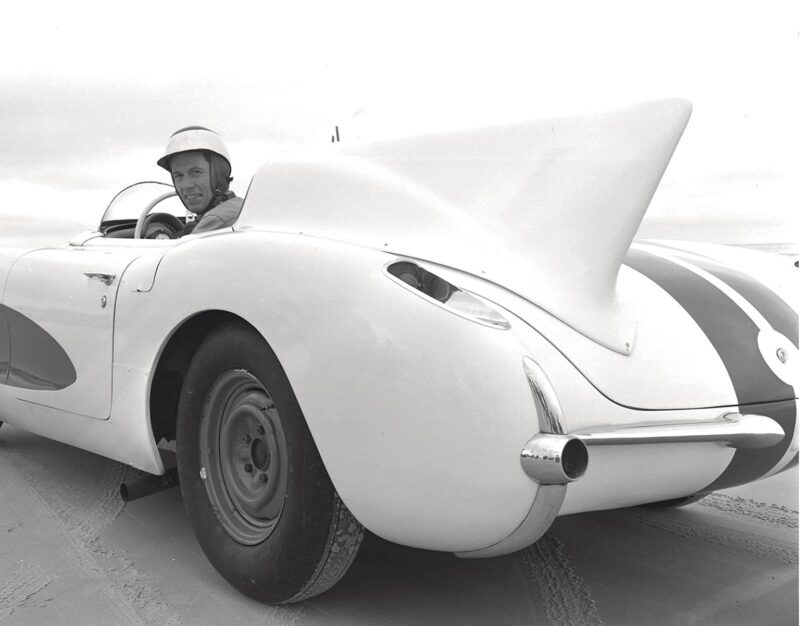
Fitch in a Corvette at Daytona Beach for a speed record attempt
GM Media
“I bought an MG Magnette – beautiful little supercharged 1100cc engine, lousy chassis – and toured Scotland and Wales in it. Then war was declared, so I tried to join the RAF’s Eagle Squadron for American volunteers. But they had plenty of pilots and not enough planes, so I got myself back to the US on another freighter, with the Magnette in the hold. I bought a 32-foot schooner and sailed it around the Gulf of Mexico for a year, and then I got into the Army Air Corps – there wasn’t a US Air Force then.
“Soon I was back in Europe, based at Debden in Cambridgeshire, flying P-51 Mustang fighters to escort our bombers across the channel. They’d take off in the dark, sometimes a hundred of them, 10 men in each bomber. A thousand men up there in this long train, labouring slowly up to 35,000 feet. Then we’d catch them up in our P-51s, and fly up and down to protect them from attack. At first, until the P-51s got wing tanks, we didn’t have the range to get to Berlin and home, so before they got to the target we’d have to turn back. They’d go on, and usually they’d lose about 10 per cent of the train.
“I kept a flat in London, so after a mission I’d get myself to London, take a girlfriend out to dinner, then catch a dawn train back to Debden to be ready for take-off. I think I was the first person to shoot down a Messerschmitt ME262, the early German jet, and for a time I was based in North Africa too, fighting Rommel. Then on February 20, 1945 – just three months before the war officially ended in Europe – I attacked a train over Germany. Locomotives were a good target, because that was the means of moving weaponry and personnel around. You could shoot the boiler full of holes and they’d patch them up overnight, but if you could get the high-pressure tank in front of the cab it would blow apart. I made one pass, didn’t get that high-pressure tank, so I made another, and missed again. Making a second pass is a bit foolish, making a third is just stupid. I made a third, and the anti-aircraft gun on the train got me.
“Immediately there was hot engine oil and smoke everywhere and I couldn’t see. We wore pressure suits to inflate over our thighs and stomachs to stop us blacking out in the high-G turns, plus all the oxygen and radio, and I couldn’t unhook all these things. The plane was going down fast and I just barely got out – the tailplane hit me as I came out, and broke my arm – and as I got loose the chute opened and then, bang, the plane hit the ground. I came down right beside it, which saved me, because when the locals came rushing up with pickaxes and shovels to finish me off they saw the wreckage on fire, burning fuel running everywhere, and my chute in the wreckage, burning too. So they didn’t bother to look for me. They reckoned the pilot was kaput. In fact I was hiding a few yards away in a ditch. A kid came up and almost looked into my face, but I kept still and he didn’t see me. Eventually they went away, and when it got dark I crawled out.
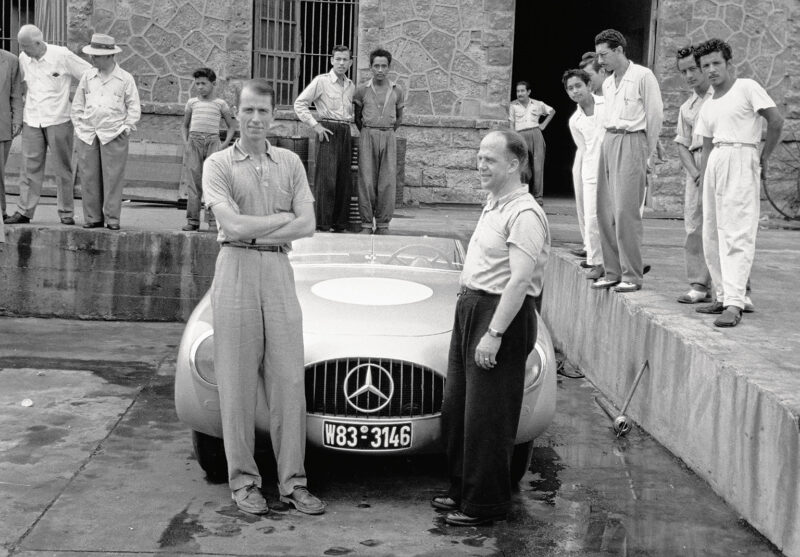
With navigator Eugen Geiger and Mercedes 300 SL for Carrera Panamericana 1952
Motorsport Images
“I was 100 miles behind enemy lines. It was winter, bitterly cold, snow on the ground. I had my escape kit – a package about the size of a paperback book that we all carried. It had silk maps, compass, candy bars, water purification chemicals, a couple of gold coins to barter with, the things you’d need if you were on the run. I set a compass course and started to walk towards the Rhine, thinking maybe I could get across the river somehow. I walked as long as I could, nursing my injured arm. Eventually I came to a farm, waited until the dogs stopped barking, crawled into a barn and went to sleep. They found me the next day, and I spent the last three months of the war in a POW camp.
“After VE Day, while the war was still going on in Asia, I was stationed at Wright Patterson Field in Ohio as a test pilot. P-51s had water injection which you could use for five minutes: any longer and you’d destroy the engine. They’d made some modifications and wanted to know how long it would last now. They sent me up and told me to run it flat out on water injection until it blew. After I don’t remember how long, the engine duly blew. I got it down OK with a dead-stick landing.
“Once the war was finished I tried farming for a bit. I hung around with Jack Kennedy in Palm Beach, dated his sister, and then in 1948 I set up a sports car dealership in White Plains, New York. I imported MGs and terrible European cars like Renaults and Austins, and I sold old jeeps and station wagons too. In June 1949 I entered my own MG TC for a sports car race at Bridgehampton. As pitcrew I took a girl called Elizabeth, an account exec at J Walter Thompson in New York. I’d never driven in a race before, and she’d never been to one.” After finishing a surprised fifth in the uncompetitive little car, John took Elizabeth to dinner, and proposed. For the next 60 years they were inseparable, until her death last year.
“I soon realised there was no future in racing MGs, because they were too slow. So I built the Fitch Bitch: Fiat 1100 chassis, Ford V8 motor and Crosley all-enveloping body. It went quite well at places like Watkins Glen. In 1950 a friend of mine, the painter Coby Whitmore, got a Jaguar XK120, and we raced that together at Sebring. It was a six-hour race then, started at 6pm, ran to midnight, and we won our class. We decided that a lightweight version of the XK would make a damn good race car. We didn’t know that Jaguar themselves were building the C-type. So Coby drew a slim aluminium cycle-winged body and I made a few other modifications, and I built it up at White Plains. The finished car looked gorgeous, and weighed 800lbs less than a standard XK. It still exists – changed hands at auction recently for $400,000.
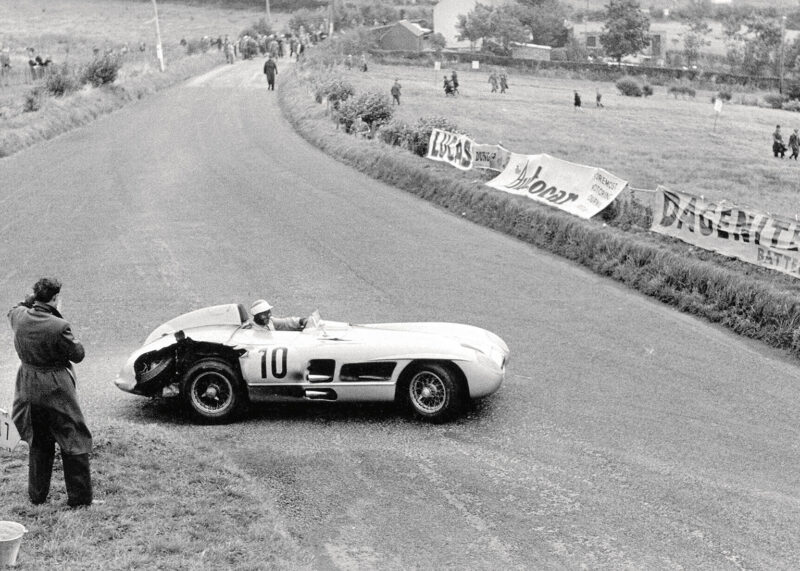
Fitch shared scarred but victorious 300 SLR with Moss in 1955 Tourist Trophy at “crazy” Dundrod
Motorsport Images
“In 1951 Tommy Cole, an Englishman who lived in the US and was racing Allards very successfully, crashed his J2 and his nightclub-owner sponsor bought him a new one. I borrowed the old one, chained the bent chassis member to a tree and backed it up hard several times, bang, bang, until I’d got it more or less straight. Then I took it down to Buenos Aires and won the Argentine Grand Prix by over a lap. I got a big trophy and a kiss from Eva Peron.”
Also that year, driving the Whitmore XK, Briggs Cunningham’s Ferrari 195 and the new Chrysler-powered Cunningham C2R, John was SCCA Champion. He drove the C2R in his first European race, the Le Mans 24 Hours, and by Sunday morning he and Phil Walters had got the big, heavy car up into a strong second place. “Of the three C-type Jaguars, two had gone out with engine trouble early on. The other one was leading, but we were sure it would have engine trouble too, and an American car was going to win the 24 Hours. It would have been one of the biggest upsets in Le Mans history. But the Jaguar engine didn’t fail, ours did. Our oil pressure went away, and we struggled home 18th.” The same year Mercury Marine millionaire Carl Kiekhaefer entered a team of Chrysler Saratoga sedans in the Carrera Panamericana road race through Mexico. The cars were fast but under-prepared, and Fitch was in the lead when the engine blew. He found the race fascinating, and vowed to return.
In 1952 John won races at home in Max Hoffman’s Jaguar C-type and Briggs Cunningham’s cars, but his new, lighter C-4R failed at Le Mans. “We were told the wrong octane rating for the French fuel, and the engine couldn’t take it. Mercedes-Benz won that year with their new 300SLs, and afterwards I congratulated their chief engineer, Rudi Uhlenhaut. He said they’d booked the Nürburgring for the day after the German Grand Prix for development testing on the 300SL, and he offered me a ride. What an opportunity! It was only a courtesy drive, but of course I wanted to bid for a place in the team by being quick. But what worried me was I didn’t know the Nürburgring.
“Well, there was a supporting GT race at the German GP, and I knew Ferry Porsche quite well, so I managed to borrow a 356 for that. I did six practice laps, started in the middle of the pack, got a feel for the place – all 14 miles and 174 corners – and worked my way up to finish third behind two more Porsches. Next morning [Mercedes team manager] Alfred Neubauer was running the test, and he wanted to concentrate on a high-speed misfire they were trying to cure. He didn’t want some American taking a tour just for the hell of it. I tried to stay in his line of sight all day, to remind him. Finally, when the day was almost over, he let me get in the car. ‘Go slow,’ he said, ‘and don’t damage the car. If you kill yourself, it’s your fault.’ But I went as fast as I dared, and I knew the track now. I did three laps, the car was beautiful, and my times were good. Afterwards – what a nerve I had – I put a pitch to Neubauer that Mercedes should do the Panamericana (see feature, p74). ‘The big Ferraris will be faster, but they won’t finish and you will. You’ll win it.’ ‘Unmöglich,’ he said. ‘Impossible. We don’t have the budget, we don’t have the time to organise it, it’s too big, too far away.’ But the following week I sent him a dossier about the race, road conditions, altitude, temperature, rainfall. I heard nothing more until the end of October, barely three weeks before the race, when I had a telegram asking me to go to Mexico City at once. Signed Neubauer, Daimler-Benz.”
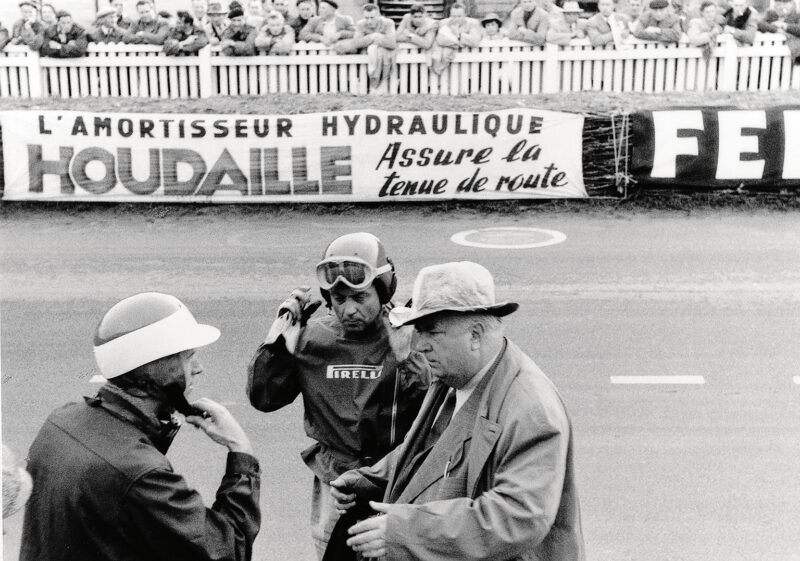
Earlier in 1955 at Le Mans with doomed Pierre Levegh and Alfred Neubauer
Motorsport Images
Three 300SLs had been entered: Gullwing coupés for Hermann Lang/Erwin Grupp and Karl Kling/Hans Klenk, and an open version for Fitch, with Eugen Geiger as navigator. Plus a practice car, two saloons, two trucks, several crates of spares and 35 staff. The race started at the bottom of Mexico near the Guatemalan border and ran 2000 miles north to Ciudad Juarez, near the edge of Texas. Fitch led the first stage until slowed by two tyre failures, which also damaged suspension and tore bodywork. That night, with Neubauer’s approval, Fitch carved makeshift scoops in the 300SL’s rear bodywork to cool the tyres, and also so Geiger could check at speed when the white breaker strips started to show. He was second to Luigi Villoresi’s Ferrari on the second stage, but thereafter more thrown treads and bent steering pushed him back. Into the fourth day, finding his steering still out of alignment, he returned to the Mercedes service garage for it to be reset, and restarted the stage late. After these delays he set fastest time on the eighth and final leg to the finish, averaging 135mph for 235 miles. This lifted him back to fourth overall behind the two Gullwings of Kling and Lang and Luigi Chinetti’s Ferrari. But the organisers decided to treat his return to the service garage as receiving outside assistance, and he was disqualified. Even so, Neubauer was happy, because the Mercedes one-two made headlines round the world.
By 1953 John and Elizabeth and their children were living in Paris, and he was fully occupied with a variety of mounts. He did the Mille Miglia in a works Nash-Healey but retired near Ravenna with diff failure, and the Tourist Trophy at Dundrod in a works Frazer Nash with Peter Wilson. With Phil Walters he won the Sebring 12 Hours in the old C-4R, but for Le Mans Cunningham built the lighter, more streamlined C-5R. John and Phil brought it home third behind two works C-types. The Cunningham team stayed on in France to do the Reims 12 Hours three weeks later, and at dawn Fitch was leading the race, ahead of the Ferraris and the Jaguars, when he had a massive shunt.
“It’s incredible how little we knew about aerodynamics in those days. To streamline the C-5R they pointed the ends and rounded the corners, and what they’d actually made was a crude aerofoil. I was going through the fast right sweep just after the pits, same speed as I’d been doing all race, but there must have been an extra gust of wind that increased the air speed over the body beyond the critical point, and the car just took off. Umberto Maglioli was following me in his Ferrari, and he said it flew higher than the telegraph poles. When I woke up the car was the right way up, not on fire, the engine was running, most of the bodywork and wheels were gone, and I didn’t know where I was. I crawled to the edge of the road and a gendarme appeared and took me back to the pits. I was more or less all right – I had a cauliflower ear and some bruises – but I was terribly concerned for Elizabeth, who was pregnant with our third son. Fortunately she was asleep and knew nothing about it. I cleaned up and put on a jacket, and when she woke I just told her I was out of the race. Later, when she saw the wreckage of the car, it made her ill.
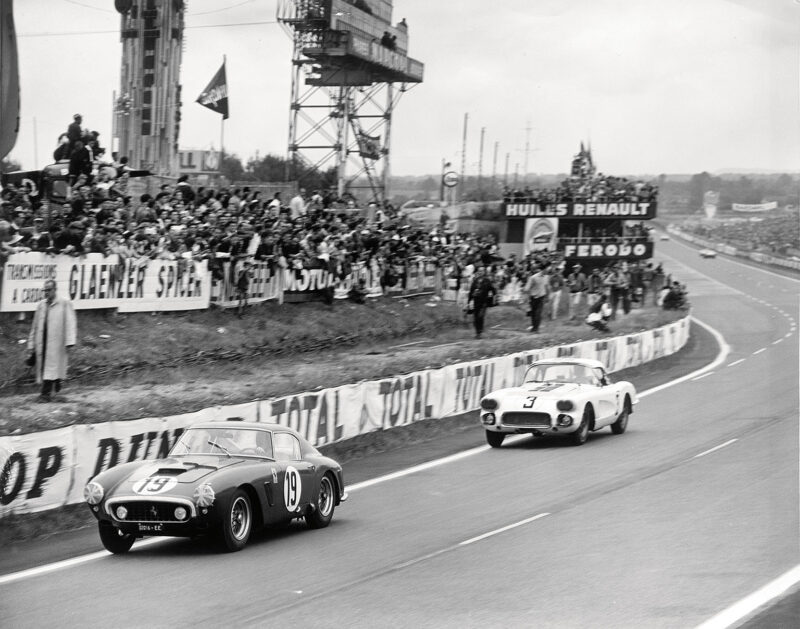
Back at La Sarthe in 1960, Fitch and Bob Grossman won their class in Cunningham Corvette
Motorsport Images
“It was my biggest accident, and I survived because I was wearing a five-point aircraft safety harness, maybe the first time such a thing had been seen in European racing. I only wore it because Briggs insisted on it. He was just an overgrown boy scout, as wholesome as could be, very considerate and always concerned about everybody’s comfort. He was wonderful with the wives and girlfriends, always running off to get them a chair. A true enthusiast, really loved his racing. He was the personification of the old joke: how d’you make a small fortune out of racing? Answer: start with a big one.”
Barely a week after the Reims crash, nursing his bruises, John was doing the Alpine Rally in a works Sunbeam. “They were dreadful cars, overweight and underpowered, and you couldn’t get the wheel nuts to stay on. But Norman Garrad, the team manager, believed in getting good drivers – people like Stirling Moss, Mike Hawthorn and Peter Collins.” Having done the 1952 Alpine and the 1953 Monte Carlo Rally in four-door saloons, he was now in one of the new two-seater Alpines. He won a Coupe des Alpes for completing the gruelling distance without penalty. Ten days later he drove a Cooper-Bristol in the Aix-les-Bains Formula 2 race, finishing fourth. In September he did the Italian GP at Monza in a works HWM, but retired with a blown engine.
In 1954 John became involved with Hollywood’s effort to produce the ultimate motor racing feature film. For The Racers (released in the UK as Such Men are Dangerous), 20th Century Fox bought a clutch of single-seater Maseratis and sports-racing Ferraris and modified them slightly to be “Buranos”, plus a 1950 cycle-winged HWM. “I know you own that car now, Simon. I love that car. Kirk Douglas never came to Europe for the filming we did at the various races. The close-ups were done later in the studio, and I had to drive the cars on location and set up all the crashes. The Monte Carlo sequence at the start of the film was a big job, because there was no Monaco Grand Prix that year, and we had to mock it up. We got Ascari and Villoresi to stand around as extras, and we put up pits and grandstands. We could only do it on a Sunday, getting the locals to act as spectators, and the churches were all dead against it. But fortunately Louis Chiron was an old friend, and he was close to Prince Rainier, so we got all the permissions. I had to crash the HWM at St Devote for the cameras, and then back in Hollywood they cut it in with Kirk Douglas leaping out with the car on fire.”
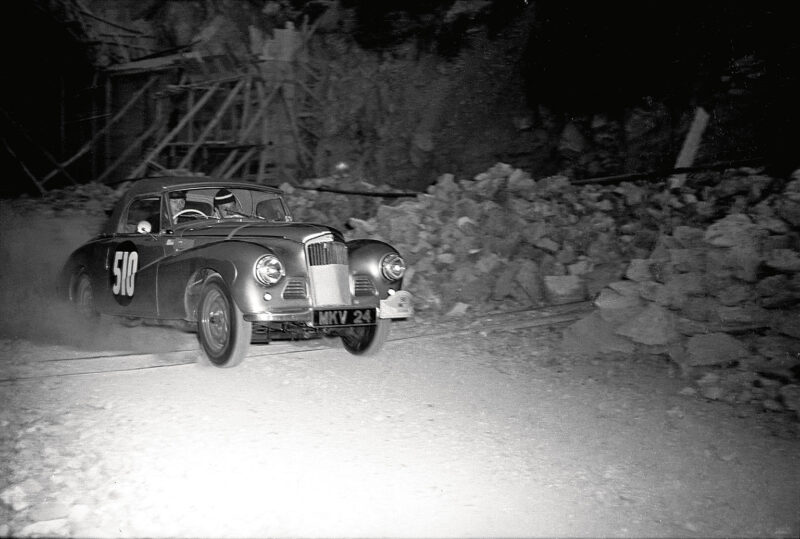
In 1953 Fitch won a Coupe des Alps on the Alpine Rally in a works Sunbeam
Motorsport Images
At Le Mans that year Briggs Cunningham tried something different. As well as the Cunninghams, he had a Ferrari 375MM, white with blue stripes, and fitted with American-developed water-cooled brakes, fed by huge twin scoops high on the nose. “A great idea, but they didn’t work.” Fitch and Walters retired the car after 13 hours.
Mercedes returned to Formula 1 in mid- 1954, and for ’55 set up a sports car assault as well with the 3-litre straight-eight 300SLR. For the Mille Miglia four of these superb machines were handled by Moss, Fangio, Kling and Herrmann. Some months earlier Neubauer had offered John a production 300SL Gullwing for the race, and John asked Motor Sport journalist Denis Jenkinson to go with him: Jenks had Mille Miglia experience, having gone with George Abecassis the year before in an HWM-Jaguar. “Elizabeth and I and our three boys were living in a house on Lake Como then, and Jenks came to see me and we discussed doing a full recce, recording every corner and hazard. Rather than using a big pad of paper or a fat notebook, I suggested we wrote everything onto a continuous roll of paper which could be mounted in a box and wound on progressively. Then Stirling asked Jenks to go with him, and of course I agreed, and Jenks took the roller idea with him. History tells how well it worked! In the end I took a guy from a German news magazine with me, who was clueless.”
But the race went brilliantly well: Fitch brought the virtually standard 300SL home fifth overall, conclusively winning the GT class, and taking a full hour off the class record. So the happy Neubauer asked John to join the 300SLR team for Le Mans.
“Neubauer was a big, terrifying figure, and everybody was afraid of him. If photographers got too close to the cars in the pits, he’d hit them over the head with that flag he always carried to chase them away. But it was a front he cultivated, to get his way with race organisers and everybody else. He was a pussycat, really, driven by a sincere passion for racing and for his team.”
For Le Mans three 300SLRs, each fitted with a huge air brake behind the cockpit, were entered for Moss/Fangio, Kling/André Simon and Pierre Levegh/Fitch. When Herrmann was injured in practice for the Monaco GP the previous month Simon had been drafted in and done a good job. Levegh, of course, had been the single-handed driver of the Lago-Talbot that so nearly beat the 300SLs in the 1952 Le Mans, and the drive was offered to him as a gesture which would perhaps be appreciated by the French public. Just 10 years after the end of World War II, there was still much anti-German feeling in France.
Probably more words have been written and spoken about the tragic 1955 Le Mans, and the accident that killed Pierre Levegh and over 80 spectators, than about any other motor racing incident. What is clear is that Mike Hawthorn’s leading D-type, having just lapped Lance Macklin’s Austin-Healey, slowed to come into the pits. Macklin swerved to the left to avoid the Jaguar, and was hit by Levegh’s Mercedes, which was projected into the crowded spectator terraces. John Fitch’s view of what happened, propounded in his writings and interviews over the past 55 years, has never changed.
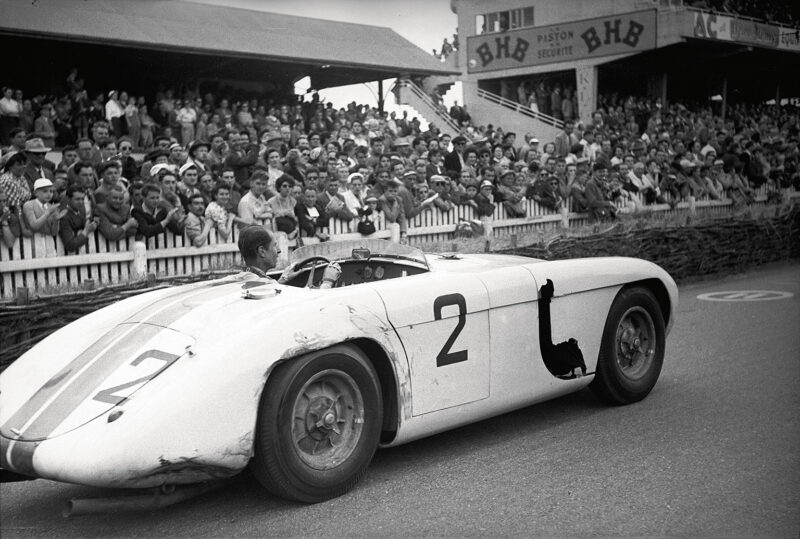
He was third in 1953 Le Mans with Phil Walters in a Cunningham C5-R
Motorsport Images
“What I have always said is that Mike Hawthorn caused the accident, but he did not cause the tragedy. The tragedy was caused by the outdated nature of the track – a start-finish straight which was actually a curve, and ridiculously narrow, so that if anything bad happened in front of the pits it was bound to project bits and pieces into the crowd.
“Pierre and I got on well. We agreed to keep a regular pace for the first half of the race, and increase speed on Sunday when the competition was getting tired. We’d done a day and night test beforehand at Hockenheim and got to know the air brake, which stabilised the car well slowing for fast corners. After two and a half hours of the race, with Fangio and Hawthorn locked in a titanic battle for the lead, Pierre was lying sixth. I was with Levegh’s wife, just going into the Mercedes caravan behind the pits for a coffee before taking over the car for my first stint, when there came the explosion of an enormous crash. I rushed to our pit, and in front of me there was a horrifying scene of chaos and smoke and debris and confusion. I could see that the burning wreckage on top of the bank was the remains of a Mercedes, but not its number. Then somebody said it was number 20, our car. At that stage I had no knowledge of the devastation in the public enclosure. In fact, the engine and front suspension had come out of the car and cut a swathe through the densely-packed crowd standing in front of the grandstand.
“First I went to Levegh’s wife – she had already realised it was Pierre in the accident and that he was dead – and then I went to find a phone to call Elizabeth. I found one, and I heard a journalist on the next phone telling his paper that he’d had it confirmed by a gendarme that at least 65 people had been killed. Until then I had no idea of the magnitude of what had happened. That was quite shocking to me. The race was going on, but at once I felt that Mercedes should withdraw. I went to Neubauer, but he wouldn’t be distracted; he was still running two cars in the race. So I told Rudi Uhlenhaut that, while it wasn’t my place to tell a director what the company should do, we surely didn’t want to have headlines saying something like: ‘Germany wins Le Mans over the dead bodies of the French.’ It would be a political disaster for Daimler-Benz. Rudi called Stuttgart, and was told that no decision could be made until all the directors had been contacted.” Finally at 1.40am, some seven hours after the accident, the order came through to withdraw.
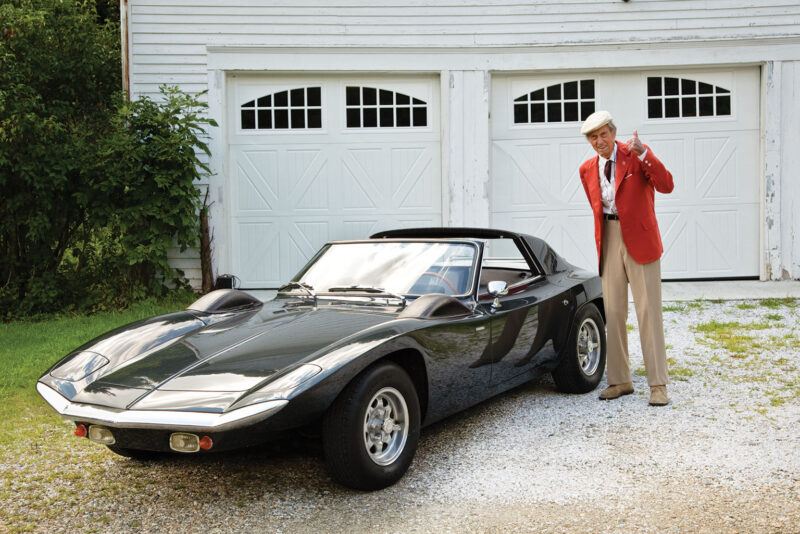
The Fitch Phoenix prototype still lives in John’s garage
“Hawthorn was a passionate racing driver, he’d been battling with Fangio for more than a Grand Prix distance, he was on the limit. He made a split-second decision to make his pitstop and braked hard in front of Macklin, who was forced into an emergency reaction. If somebody slams on their brakes in front of you, your first instinct is to miss him. So he swerved left, and Levegh hit him. In fact Hawthorn was horrified at what had happened. Rob Walker said that, after Ivor Bueb had taken over the D-type, a highly emotional Hawthorn came over to him and Macklin. He said the accident was all his fault, and begged Macklin to forgive him. Tony Rolt’s wife Lois poured him a tumbler of brandy and told him to shut up. Then [Jaguar team manager] Lofty England sat him down and convinced him that he was not to blame, and the Hawthorn/Bueb D-type raced on to victory. Thereafter Mike always maintained he was blameless.”
In September, a week after finishing ninth in the Italian GP at Monza in Stirling Moss’ own 250F Maserati, Fitch was paired with Moss for the Tourist Trophy at Dundrod: “a crazy place, very narrow, very fast”. Three more drivers – Jim Mayers, Bill Smith and Richard Mainwaring – were killed that day. Stirling was in a class of his own on that track, and Fitch only drove the car for half an hour to give The Boy a brief rest. Their 300SLR won by a full lap from team-mates Fangio and Kling, although the Hawthorn/Desmond Titterington D-type was second with two laps to go when its engine blew. Neubauer was so impressed with Irishman Titterington’s speed on his home circuit that he drafted him into the 300SLR team for its last race, the Targa Florio, sharing with Fitch.
“The 300SLR was so tough. I made a mistake on the Targa: I slid sideways on gravel into a big stone wall with a terrible crashing bang, up in the air, down again on its wheels. I thought, I’ve wrecked this car for sure, but the steering was all right, so were the brakes, it didn’t pull to one side or the other, it ran just as well as before. Stirling was with Peter Collins for this race and they both crashed: Stirling went off into a field, but got it back to the pits for repairs. Then, avoiding a slower car, Collins hit a wall, and had to come in for bodywork to be pulled off the tyres. They still won by nearly five minutes, from Fangio/Kling and the Castellotti/Manzon Ferrari. We were fourth, 12 minutes behind Stirling and Pete after nearly 10 hours’ racing.”

In Stirling’s 250F on the Monza banking at 1955 Italian GP
Motorsport Images
At the end of the 1955 season John returned home, and was hired by General Motors to develop the eminently unsuitable Chevrolet Corvette (“Not a car you’d want to race”) into a class winner. At Sebring in ’56, after endless problems, he and Walt Hansgen struggled home ninth, and did win their class. In ’57 he and Piero Taruffi debuted the spaceframe Corvette SS, but retired it early. In 1960 Briggs Cunningham took three Corvettes to Le Mans and, despite severe overheating (and with its engine packed with ice taken from Briggs’ hospitality), the Fitch/Bob Grossman car came home a heroic eighth overall, and won its class.
This year Fitch returned to Le Mans to do a lap of honour in the same Corvette, half a century on. Race officials expected the then 92-year-old to be a passenger in the car. John said if they didn’t let him drive it he was flying straight home. He drove it.
Through the late 1950s and into the ’60s Fitch continued to race for Briggs Cunningham and others, in Jaguar D-type, Lister-Jaguar, Birdcage Maserati, Cooper Monaco and Porsche RSK. In 1966 the two friends shared a Porsche 904 in the Sebring 12 Hours. Briggs was 59, John was 48. When a valve spring broke the car was retired, and they both retired with it.
But John’s life was as busy as ever. He’d been involved with the Lime Rock circuit ever since it was first laid out in 1956. “Jim Vail, whose family owned the land, had seen Watkins Glen and wanted to do the same in Connecticut. Bill Milliken and I worked on the final layout, and I moved up here to run the track. It’s a mile and a half, a real road course with good corners and changes of gradient, so lots of good, safe vantage points for spectators. It’s been going successfully for over 50 years. Skip Barber owns it now.”
In 1966, having successfully marketed his Sprint version of the Chevrolet Corvair with engine, suspension and styling improvements, John decided that the Corvair flat-six air-cooled engine and suitably modified running gear could make the basis of an American Porsche. His friend Coby Whitmore came up with a supremely elegant shape, and a deal was done with Intermeccanica in Turin to build the body in steel. He called it the Fitch Phoenix. Then Ralph Nader published his book Unsafe at Any Speed. Almost overnight General Motors killed the Corvair, and the Phoenix died with it. The single prototype resides in John’s garage, and he still drives it around Lakeville. It’s hard to believe this low, crisp and elegant design is 44 years old.
John Fitch’s 1955 Le Mans experience made him very aware of safety. “I worried about it for years: how do you stop an errant vehicle from high speed in a very small space without killing the occupants?” After much experimentation he came up with the Fitch Barrier, based on sand-filled frangible barrels. It took a long time for him to gain acceptance from the US authorities, but now they are used on highways all over America. It was followed by displaceable and compression barriers for race track use. For race driver safety he has designed a safety-cell seat with helmet support which he reckons is an improvement on the HANS device. Other inventions include a waterless cooling system for cars, a secondary braking system for trucks and buses, a permanent fuel catalyst, and self-levelling suspension. That’s before we get to his Cervical Spine Traction, which allows back sufferers to move in bed while retaining pressure on painful discs, and his ecologically efficient Thermo-Syphon Fireplace for houses.
For a man of his years John Fitch is extraordinarily energetic. He puts this down to a sense of urgency. “I feel I have so much to get done, and I’m already a decade past the lifespan of a typical Western male. I have to be prepared, any day, to become incompetent.” This determination to keep going while he can impelled him towards one last competitive drive in 2005, when he was already 88. He tried for new class speed records on the Bonneville Salt Flats in a 50-year-old 300SL Gullwing. Disappointingly, a faulty fuel injection pump and then rain kept him down to 150mph. But if there is a speed record for 88-year-olds – or, indeed, a Le Mans lap record for 92-year-olds – you can be sure that John Fitch already has it. This is a most unusual man.
